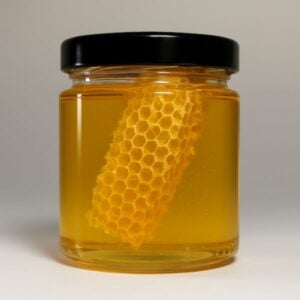The Beehive Blog
Lavender Honey Benefits: The Delicate Taste of Nature
Lavender honey benefits go far beyond its taste. This monofloral raw honey, harvested in small batches from bees that forage primarily on Lavandula angustifolia, delivers a unique floral profile and powerful health properties.
Unlike infused honey, ours contains no added lavender oil or dried flowers. The delicate flavour you taste comes purely from nature—unprocessed, unpasteurised, and gently filtered to retain every drop of goodness.

The Origins of Our Lavender Honey
Our bees collect nectar from wild lavender fields in Bulgaria, surrounded by meadows filled with wildflowers. Every batch of honey captures subtle differences in flavour, colour, and aroma due to local blooms and seasonal changes.
This makes each jar a one-of-a-kind expression of the land and flowers.
What Makes Lavender Honey Unique?
Botanical Name
Lavandula angustifolia, also called English lavender or true lavender.
Taste and Texture
Floral, well-balanced, and aromatic
Medium sweetness with a lasting floral finish
Occasionally reveals faint sour notes without bitterness
Slight acidity keeps the flavour bright and clean
Colour
Ranges from pale yellow to golden amber—like liquid sunshine in a jar.
Crystallisation
Lavender honey typically crystallises within a few months. As it solidifies, its colour becomes lighter, forming a smooth, creamy texture ideal for spreading.
Note on Lavender Varieties
Different species yield different flavours. For example, Spanish lavender (Lavandula stoechas) produces honey with higher camphor content, resulting in a more bitter, almond-like taste. Our honey, from Lavandula angustifolia, remains gentle and balanced.
Culinary Uses of Lavender Honey
Lavender honey is incredibly versatile. It pairs beautifully with:
Feta, goat cheese, and blue cheese
Croissants, toast, waffles, and biscuits
Hot herbal tea and lemon water
Baking and desserts
Yoghurts, smoothies, and fresh fruit
Ice cream, especially when used as a drizzle or mixed into the base
Try it with triple-crème cheeses like Pierre Robert or Brillat-Savarin. You’ll find it elevates both sweet and savoury dishes.
Lavender Honey Benefits for Health
1. Antifungal Protection
Studies show lavender honey fights fungi such as Candida albicans, Candida krusei, and Cryptococcus neoformans. It doesn’t rely on sugar content to achieve these effects. Instead, natural compounds in the honey provide antifungal action, especially useful for mycotic infections.
2. High in Antioxidants
This honey contains powerful flavonoids and phenolic compounds, including naringenin, luteolin, gallic acid, and caffeic acid. These antioxidants reduce oxidative stress and support long-term health by neutralising free radicals that contribute to cancer, cardiovascular disease, and inflammation.
3. Wound Healing and Skin Repair
Thanks to its antibacterial and anti-inflammatory properties, lavender honey works well for treating wounds, cuts, and burns. It promotes skin regeneration, keeps wounds clean, and prevents infection.
Its calming effect also helps reduce irritation, making it ideal for natural skin care.
4. Clearer, Healthier Skin
Lavender honey supports acne-prone and sensitive skin. It unclogs pores, reduces redness, and gives dull skin a natural glow. Its light texture makes it suitable for regular facial treatments or as an ingredient in homemade masks.
5. Natural Relief for Respiratory Infections
Lavender honey soothes sore throats and calms persistent coughs. Its thick consistency coats the throat, while its antibacterial components fight infection and inflammation. For best results, enjoy it in warm tea or directly off the spoon.
Final Thoughts on Lavender Honey
From its aromatic flavour to its proven medicinal properties, lavender honey benefits the body and mind. Whether you’re using it in recipes, teas, skincare, or natural remedies, it’s more than a luxury—it’s a healing food.
But there’s one thing you’ll have to experience for yourself: its floral finish, delicate yet lingering. No words can replace that first taste.
Author:
Princess Bee Honey Co.
-
Out Of Stock






